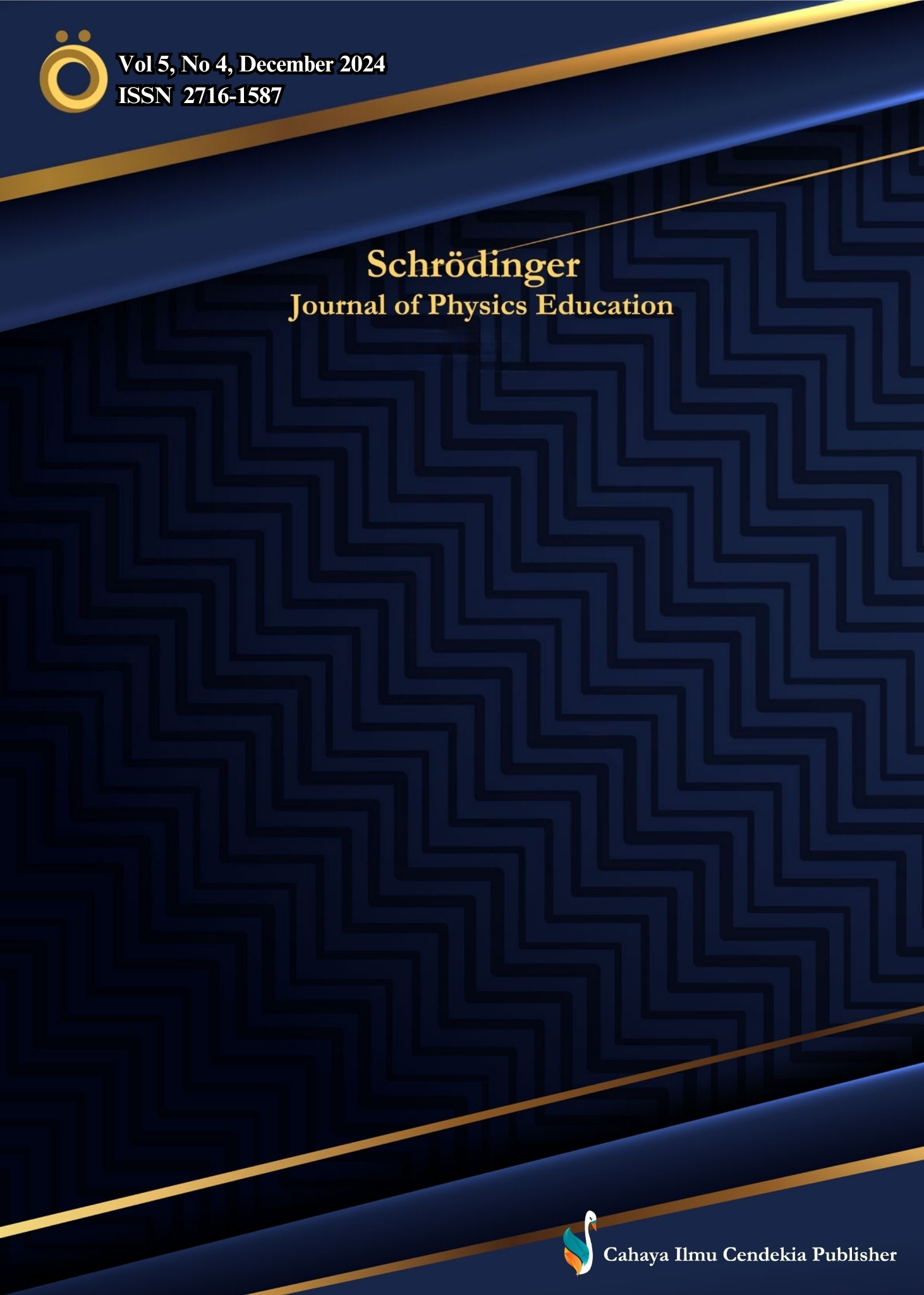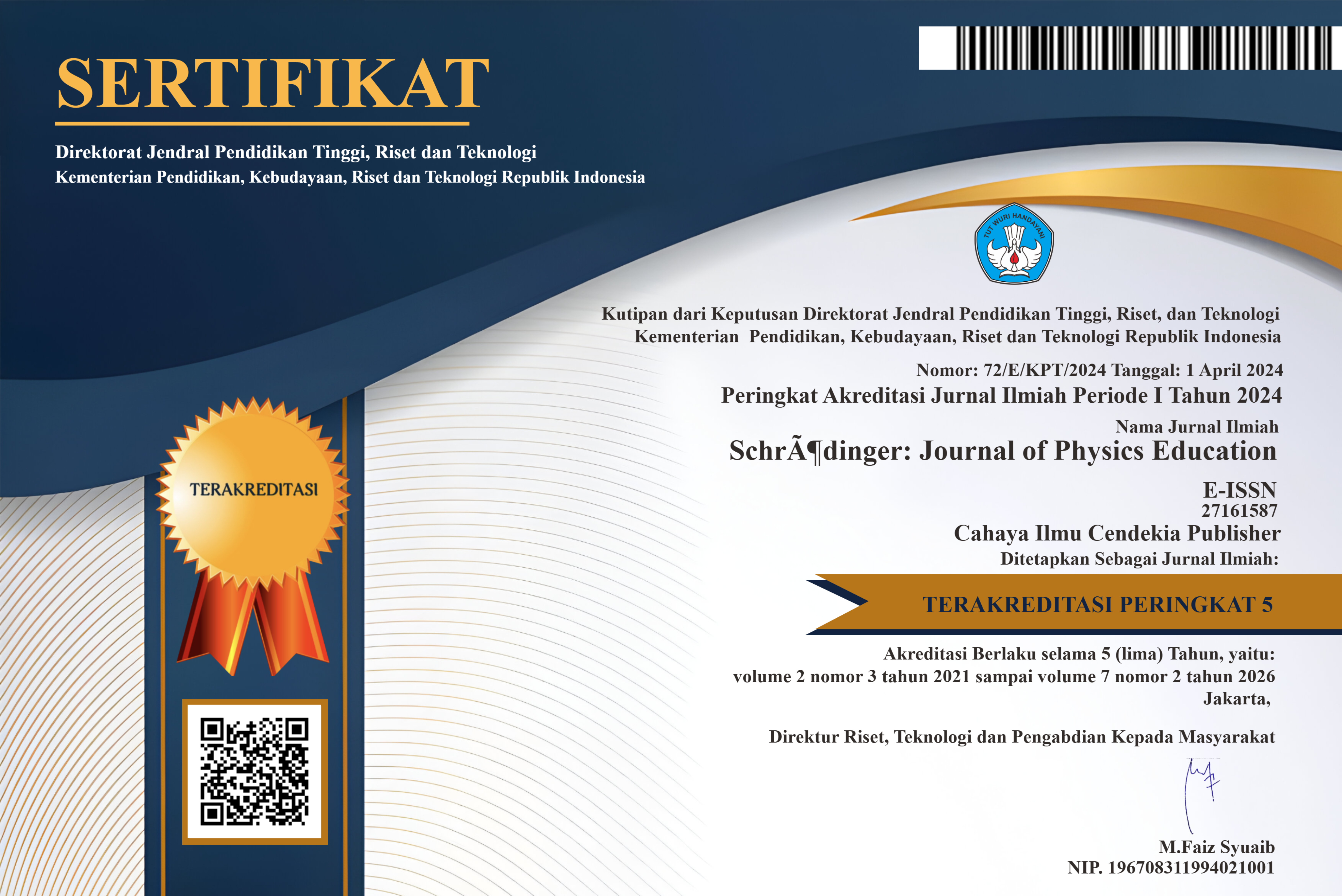The Effectiveness of Powerpoint-Based Audio Visual Media on Science Learning Outcomes on Solar System Material in Class VII Students
Abstract
Purpose of the study: To determine the effectiveness of power point-based audio visual media on student learning outcomes regarding the solar system in class VII in junior high school
Methodology: This type of research is quantitative research with a quasi experimental research method. The research carried out involved two classes, a control class and an experimental class. Simple random sampling technique. The class that is the control class is class VII C while the class that is the experimental class is class VII D. The instruments used in this research were questionnaires and questions. The data collection method for this research was carried out using pretest and posttest. The data analysis technique used in this research is the T-test using the SPSS program.
Main Findings: Main findings of this study reveal that the use of PowerPoint-based audiovisual media significantly enhances students' learning outcomes in the Solar System topic. Statistical analysis shows a significant difference between the experimental and control groups, with higher scores for the experimental group. The media effectively improves understanding of complex materials and increases student motivation. This practical, interactive approach highlights the potential of simple technology in science education, providing new empirical evidence and a scalable solution for improving learning in diverse educational contexts.
Novelty/Originality of this study: This research is the basis for developing a science study on learning media regarding the solar system using Power Point learning media for class VII junior high school students.
References
N. T. Handayani, T. Krobthong, and K. Goodwell, “Descriptive Study: Student Learning Motivation in Learning Physics of Renewable Energy Materials,” Schrödinger J. Phys. Educ., vol. 4, no. 4, pp. 98–103, 2023, doi: 10.37251/sjpe.v4i4.775.
M. Maison, D. A. Kurniawan, R. P. Wirayuda, and D. Chen, “Process Skills-Based E-Module: Impact On Analytical Thinking Skills,” J. Penelit. Pengemb. Pendidik. Fis., vol. 8, no. 1, pp. 23–34, 2022, doi: 10.21009/1.08103.
P. Zhang and S. Li, “Associative cultural landscape approach to interpreting traditional ecological wisdom: A case of Inuit habitat,” Front. Archit. Res., vol. 13, no. 1, pp. 79–96, 2023, doi: 10.1016/j.foar.2023.09.008.
L. N. Rufaidah, N. Umamah, Sumardi, Marjono, and R. A. Surya, “Learning environment technology-based in improving students’ independent learning,” IOP Conf. Ser. Earth Environ. Sci., vol. 747, no. 1, 2021, doi: 10.1088/1755-1315/747/1/012056.
D. G. H. Divayana, P. W. A. Suyasa, and N. K. Widiartini, “An innovative model as evaluation model for information technology-based learning at ICT vocational schools,” Heliyon, vol. 7, no. 2, p. e06347, 2021, doi: 10.1016/j.heliyon.2021.e06347.
B. Boy, H. J. Bucher, and K. Christ, “Audiovisual science communication on TV and youtube. How recipients understand and evaluate science videos,” Front. Commun., vol. 5, no. December, pp. 1–18, 2020, doi: 10.3389/fcomm.2020.608620.
C. Nicolaou, “Media trends and prospects in educational activities and techniques for online learning and teaching through television content: Technological and digital socio-cultural environment, generations, and audiovisual media communications in education,” Educ. Sci., vol. 11, no. 11, 2021, doi: 10.3390/educsci11110685.
M. Poongodi, M. Hamdi, and H. Wang, “Image and audio caps: automated captioning of background sounds and images using deep learning,” Multimed. Syst., vol. 29, no. 5, pp. 2951–2959, 2023, doi: 10.1007/s00530-022-00902-0.
V. Sampath, I. Maurtua, J. J. Aguilar Martín, and A. Gutierrez, A survey on generative adversarial networks for imbalance problems in computer vision tasks, vol. 8, no. 1. Springer International Publishing, 2021. doi: 10.1186/s40537-021-00414-0.
E. Y. R. Pratiwi and M. B. E. Siswanto, “Pengembangan education game berbasis microsoft power point dalam media pembelajaran pendidikan kewarganegaraan,” DWIJA CENDEKIA J. Ris. Pedagog., vol. 4, no. 1, p. 162, 2020, doi: 10.20961/jdc.v4i1.43331.
S. Fitriyah, Supriyono, and S. Rahayuningsih, “E-modul pembelajaran terpadu dengan model immersed berbasis kearifan lokal untuk meningkatkan literasi budaya siswa sekolah dasar,” Pendas J. Ilm. Pendidik. Dasar, vol. 9, no. 2, pp. 2156–2165, 2024.
G. P. Yustika and S. Iswati, “Digital Literacy in Formal Online Education: A Short Review,” Din. Pendidik., vol. 15, no. 1, pp. 66–76, 2020, doi: 10.15294/dp.v15i1.23779.
E. F. Crawley, A. Hosoi, G. L. Long, T. Kassis, W. Dickson, and A. B. Mitra, Moving Forward with the new engineering education transformation (NEET) program at MIT - Building community, developing projects, and connecting with industry. 2019. doi: 10.18260/1-2--33124.
A. G. Spatioti, I. Kazanidis, and J. Pange, “A comparative study of the ADDIE instructional design model in distance education,” Inf., vol. 13, no. 9, pp. 1–20, 2022, doi: 10.3390/info13090402.
F. Mulisa, “Sampling techniques involving human subjects: Applications, pitfalls, and suggestions for further studies,” Int. J. Acad. Res. Educ., vol. 8, no. 1, pp. 75–84, 2022, doi: 10.17985/ijare.1225214.
E. Noviana et al., “Why is didactic transposition in disaster education needed by prospective elementary school teachers?,” Heliyon, vol. 9, no. 4, p. e15413, 2023, doi: 10.1016/j.heliyon.2023.e15413.
R. Y. Nooraie, J. E. M. Sale, A. Marin, and L. E. Ross, “Social network analysis: an example of fusion between quantitative and qualitative methods,” J. Mix. Methods Res., vol. 14, no. 1, pp. 110–124, 2020, doi: 10.1177/1558689818804060.
C. P. Leng and N. A. Atan, “Blending synchronous and asynchronous based on visualization strategy in music lesson to promote music students’ performance skill,” Innov. Teach. Learn. J., vol. 7, no. 2, pp. 1–18, 2023, doi: https://doi.org/10.11113/itlj.v7.130.
İ. MUDASİH and W. T. SUBROTO, “Comparison of student learning outcomes through video learning media with powerpoint,” Int. J. Educ. Res. Rev., vol. 4, no. 2, pp. 183–189, 2019, doi: 10.24331/ijere.517997.
D. Nofrizal, H. Setijono, H. Setyawati, and Nasuka, “The Tual Sagu and Golek Sagu: Traditional Sports of the Meranti Archipelago Community, Indonesia,” Int. J. Hum. Mov. Sport. Sci., vol. 11, no. 2, pp. 285–291, 2023, doi: 10.13189/saj.2023.110204.
H. Mansyur, S. W. Oktavia, Andriyanto, and Susbiyanto, “EduPhysics : Journal of Physics Education Volume 9 Number 2 , August 2024,” EduPhysics J. Phys. Educ. Vol., vol. 9, no. 2, pp. 165–172, 2024, doi: 10.59052/eduphysics.v9i1.32656.
E. Triani, L. Oktami, D. Inghug, and N. N. Rizqiyah, “Unlocking cognitive potential: enhancing problem-solving abilities through innovative problem-based learning models,” EduFisika J. Pendidik. Fis., vol. 9, no. 1, pp. 54–62, 2024, doi: 10.59052/edufisika.v9i1.32651.
D. A. F. A. Fitria and N. Nurafni, “Audio Visual Learning Media Based on Microsoft Powerpoint With Materials for Summary and Reduction of Class III Mathematics Courses,” J. Pedagog. dan Pembelajaran, vol. 4, no. 2, p. 274, 2021, doi: 10.23887/jp2.v4i2.37019.
K. Maharana, S. Mondal, and B. Nemade, “A review: Data pre-processing and data augmentation techniques,” Glob. Transitions Proc., vol. 3, no. 1, pp. 91–99, 2022, doi: 10.1016/j.gltp.2022.04.020.
R. Maskeliūnas, A. Kulikajevas, T. Blažauskas, R. Damaševičius, and J. Swacha, “An interactive serious mobile game for supporting the learning of programming in javascript in the context of eco-friendly city management,” Computers, vol. 9, no. 4, pp. 1–18, 2020, doi: 10.3390/computers9040102.
I. Wayan Santyasa, K. Agustini, and N. W. Eka Pratiwi, “Project based e-learning and academic procrastination of students in learning chemistry,” Int. J. Instr., vol. 14, no. 3, pp. 909–928, 2021, doi: 10.29333/iji.2021.14353a.
J. Maknun, “Implementation of Guided Inquiry Learning Model to Improve Understanding Physics Concepts and Critical Thinking Skill of Vocational High School Students,” Int. Educ. Stud., vol. 13, no. 6, p. 117, 2020, doi: 10.5539/ies.v13n6p117.
K. Altmeyer, S. Kapp, M. Thees, S. Malone, J. Kuhn, and R. Brünken, “The use of augmented reality to foster conceptual knowledge acquisition in STEM laboratory courses—Theoretical background and empirical results,” Br. J. Educ. Technol., vol. 51, no. 3, pp. 611–628, 2020.
P. Damayanti, “Empowering moral values: the role of pencak silat tapak suci in moral internalization through extracurricular activities,” J. Pendidik. Agama Islam Indones., vol. 5, no. 2, pp. 65–71, 2024, doi: 10.37251/jpaii.v5i2.995.
M. W. Habibi, L. Jiyane, and Z. Özşen, “Learning revolution: the positive impact of computer simulations on science achievement in madrasah ibtidaiyah,” J. Educ. Technol. Learn. Creat., vol. 2, no. 1, pp. 13–19, 2024, doi: 10.37251/jetlc.v2i1.976.
S. G. U. Lala, P. Prabowo, and S. Suryanti, “The effectiveness of integrated learning of immersed models to improve students’ ability on the environment,” Adv. Soc. Sci. Educ. Humanit. Res., vol. 212, pp. 205–207, 2018, doi: 10.2991/icei-18.2018.45.
D. Supriadi, G. F. Friskawati, and V. A. Karisman, “Physical Fitness of Futsal Athletes in Competition Preparation,” Int. J. Hum. Mov. Sport. Sci., vol. 11, no. 1, pp. 71–76, 2023, doi: 10.13189/saj.2023.110109.
V. Amrhein, D. Trafimow, and S. Greenland, “Inferential statistics as descriptive statistics: there is no replication crisis if we don’t expect replication,” Am. Stat., vol. 73, no. sup1, pp. 262–270, 2019, doi: 10.1080/00031305.2018.1543137.
F. Orcan, “Parametric or non-parametric: skewness to test normality for mean comparison,” Int. J. Assess. Tools Educ., vol. 7, no. 2, pp. 255–265, 2020, doi: 10.21449/ijate.656077.
M. Akhir, J. Siburian, and M. H. Effendi, “A study comparison the application of discovery learning and problem based learning models on the critical thinking ability,” Integr. Sci. Educ. J., vol. 4, no. 2, pp. 84–89, 2023, doi: 10.37251/isej.v4i2.390.
H. Susanto, D. Setiawan, S. Mahanal, Z. Firdaus, and C. Tsany Kusmayadi, “Development and evaluation of e-comic nervous system app to enhance self-directed student learning,” JPBI (Jurnal Pendidik. Biol. Indones., vol. 10, no. 1, pp. 143–153, 2024, doi: 10.22219/jpbi.v10i1.31451.
E. W. Simamora, “The effect of student team achievement division cooperative learning on the concept understanding ability of mathematic,” Adv. Soc. Sci. Educ. Humanit. Res., vol. 104, no. 22, pp. 407–411, 2017, doi: 10.2991/aisteel-17.2017.87.
H. Sabil, D. Agus Kurniawan, R. Perdana, P. Ayu Rivani, and R. Ilham Widodo, “The Character of Students’ Love for Their Homeland on Electronic Modules Assisted by Assemblr Edu in Learning,” Int. J. Elem. Educ., vol. 7, no. 2, pp. 335–341, 2023, [Online]. Available: https://doi.org/10.23887/ijee.v7i2.57915
A. Öztürk and A. Doğanay, “Development of argumentation skills through socioscientific issues in science course : a collaborative action research 1 fen bilimleri dersinde sosyobilimsel konularla argümantasy on becerisi geliştirilmesi : bir işbirlikçi eylem araştırması öz,” Turkish Online J. Qual. Inq., vol. 10, no. 1, pp. 52–89, 2019.
A. Taqwiem, “The character of love to the country in the novel ‘5 cm,” Adv. Soc. Sci. Educ. Humanit. Res., vol. 274, pp. 5–9, 2018, doi: 10.2991/iccite-18.2018.2.
J. A. Bawalsah et al., “Students with and without handwriting difficulties,” Adv. Soc. Sci. Educ. Humanit. Res., vol. 17, no. 7, pp. 2447–2461, 2022.
E. . Anisimova, “Digital Literacy of Future Preschool Teachers Ellina Sergeevna Anisimova 1,” J. Soc. Stud. Educ. Res., vol. 11, no. 1, pp. 230–253, 2020, [Online]. Available: https://files.eric.ed.gov/fulltext/EJ1251924.pdf
I. G. P. E. Suantara, A. Amartey, and J. P. Kankani, “The Influence of the STAD and PowerPoint-Assisted Jigsaw Models on Economics Learning Achievement,” J. Soc. Knowl. Educ., vol. 4, no. 4, pp. 122–128, 2023, doi: 10.37251/jske.v4i4.756.
H. Biarty, “Pengembangan multimedia powerpoint pada materi benda dan sifatnya kelas v sd negeri 64/i muara bulian,” Indones. J. Educ. Res., vol. 2, no. 1, pp. 7–11, 2021, doi: 10.37251/ijoer.v2i1.516.
Y. Karaca, “Computational complexity-based fractional-order neural network models for the diagnostic treatments and predictive transdifferentiability of heterogeneous cancer cell propensity,” Chaos Theory Appl., vol. 5, no. 1, pp. 34–51, 2023, doi: 10.51537/chaos.1249532.
I. P. Canlas and M. Karpudewan, “Blending the Principles of Participatory Action Research Approach and Elements of Grounded Theory in a Disaster Risk Reduction Education Case Study,” Int. J. Qual. Methods, vol. 19, pp. 1–13, 2020, doi: 10.1177/1609406920958964.
K. Lee and M. Fanguy, “Online exam proctoring technologies: Educational innovation or deterioration?,” Br. J. Educ. Technol., vol. 53, no. 3, pp. 475–490, 2022, doi: 10.1111/bjet.13182.
R. Sari, I. I. Omeiza, and M. A. Mwakifuna, “The influence of number dice games in improving early childhood mathematical logic in early childhood education,” Interval Indones. J. Math. Educ., vol. 1, no. 2, pp. 61–66, 2023, doi: 10.37251/ijome.v1i2.776.
Copyright (c) 2024 Feliza Paramitha Sinaga, Adelakun Isaac Tosin, Amit Kumar Das

This work is licensed under a Creative Commons Attribution 4.0 International License.
Authors who publish with this journal agree to the following terms:
- Authors retain copyright and acknowledge that the Schrödinger: Journal of Physics Education is the first publisher licensed under a Creative Commons Attribution 4.0 International License.
- Authors are able to enter into separate, additional contractual arrangements for the non-exclusive distribution of the journal's published version of the work (e.g., post it to an institutional repository or publish it in a book), with an acknowledgment of its initial publication in this journal.
- Authors are permitted and encouraged to post their work online (e.g., in institutional repositories or on their website) prior to and during the submission process, as it can lead to productive exchanges and earlier and greater citation of published work.







.png)
.png)








.png)
.png)
.png)







